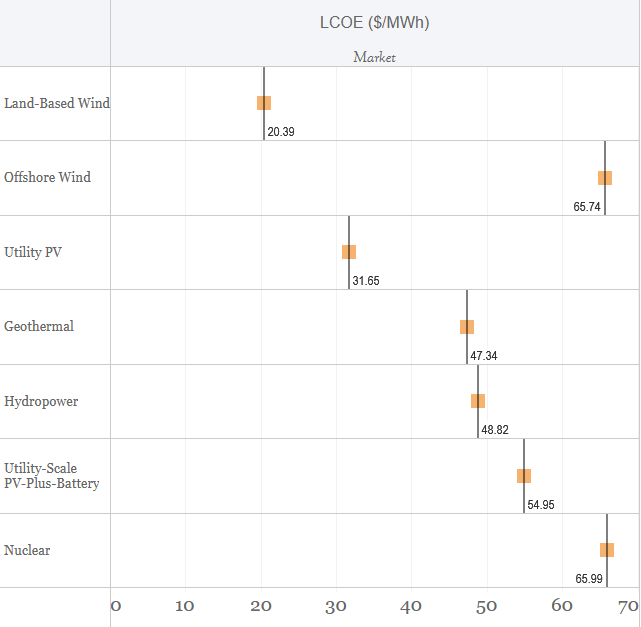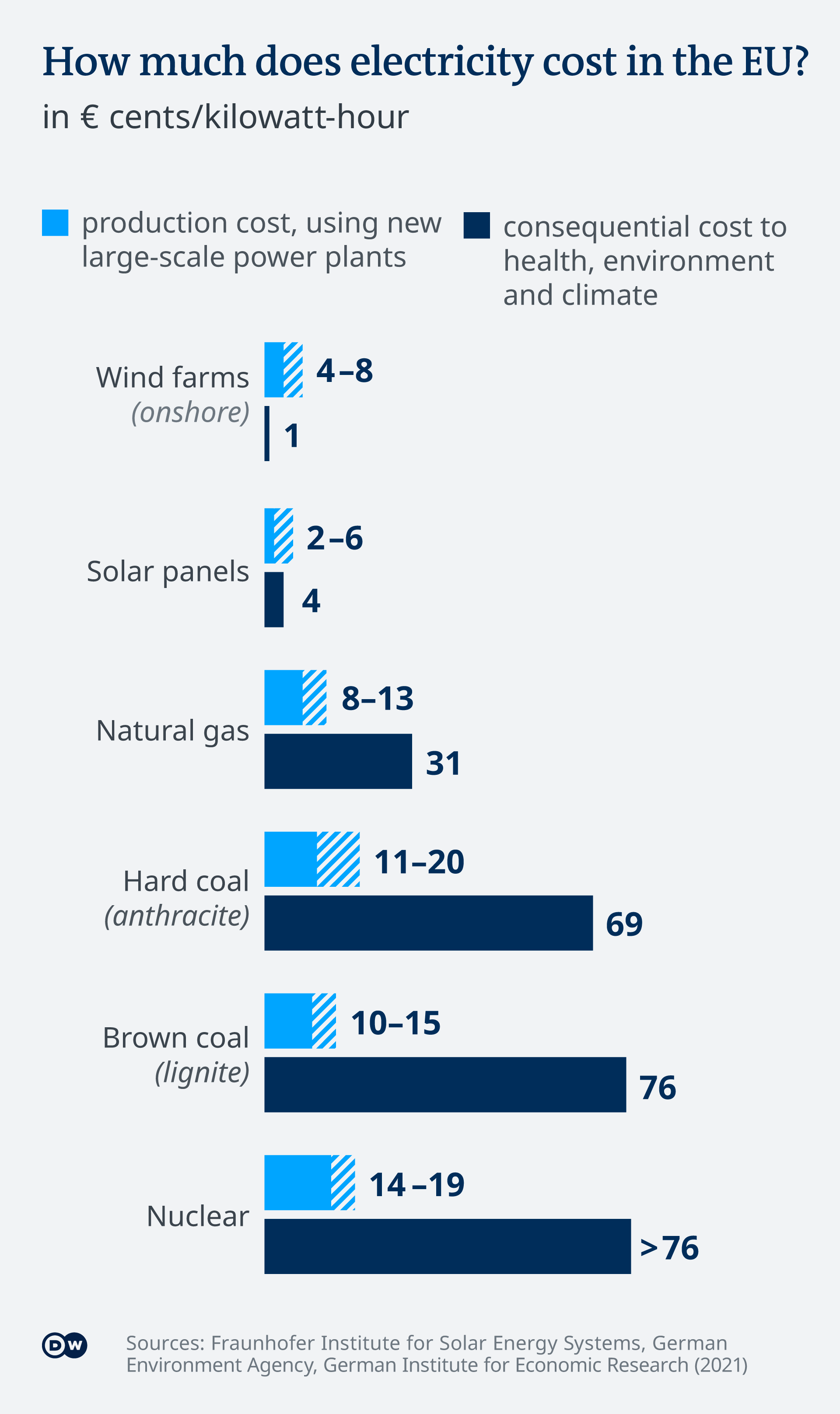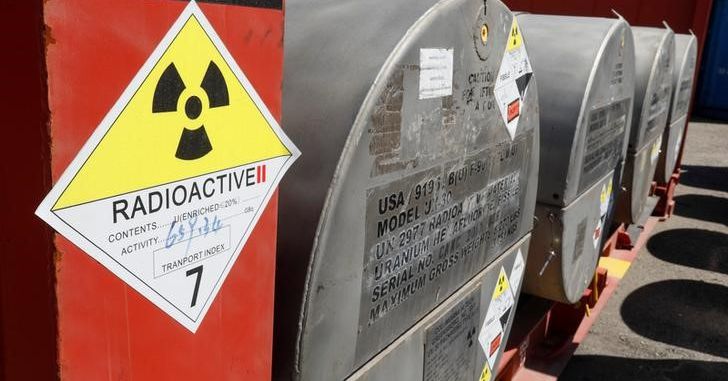Nuclear capacity is expected to rise by 14% by 2030 and surge by 76% to 686 GWe by 2040, the report said
This is only good news if it displaces thermal coal and gas generating stations.
When it comes to generating electricity, nuclear is hugely more expensive than renewables. Every 1000Wh of nuclear power could be 2000-3000 Wh solar or wind.
If you’ve been told “it’s not possible to have all power from renewable sources”, you have been a victim of disinformation from the fossil fuel industry. The majority of studies show that a global transition to 100% renewable energy across all sectors – power, heat, transport and industry – is feasible and economically viable.
This is all with current, modern day technology, not with some far-off dream or potential future tech such as nuclear fusion, thorium reactors or breeder reactors.
Compared to nuclear, renewables are:
- Cheaper
- Lower emissions
- Faster to provision
- Less environmentally damaging
- Not reliant on continuous consumption of fuel
- Decentralised
- Much, much safer
- Much easier to maintain
- More reliable
- Much more capable of being scaled down on demand to meet changes in energy demands
Nuclear power has promise as a future technology. But at present, while I’m all in favour of keeping the ones we have until the end of their useful life, building new nuclear power stations is a massive waste of money, resources, effort and political capital.
Nuclear energy should be funded only to conduct new research into potential future improvements and to construct experimental power stations. Any money that would be spent on building nuclear power plants should be spent on renewables instead.
Frequently asked questions:
- But it’s not always sunny or windy, how can we deal with that?
While a given spot in your country is going to have periods where it’s not sunny or rainy, with a mixture of energy distribution (modern interconnectors can transmit 800kV or more over 800km or more with less than 3% loss) non-electrical storage such as pumped storage, and diversified renewable sources, this problem is completely mitigated - we can generate wind, solar or hydro power over 2,000km away from where it is consumed for cheaper than we could generate nuclear electricity 20km away.
- Don’t renewables take up too much space?
The United States has enough land paved over for parking spaces to have 8 spaces per car - 5% of the land. If just 10% of that space was used to generate solar electricity - a mere 0.5% - that would generate enough solar power to provide electricity to the entire country. By comparison, around 50% of the land is agricultural. The amount of land used by renewable sources is not a real problem, it’s an argument used by the very wealthy pro-nuclear lobby to justify the huge amounts of funding that they currently receive.
- Isn’t Nuclear power cleaner than renewables?
No, it’s dirtier. You can look up total lifetime emissions for nuclear vs. renewables - this is the aggregated and equalised environmental harm caused per kWh for each energy source. It takes into account the energy used to extract raw materials, build the power plant, operate the plant, maintenance, the fuels needed to sustain it, the transport needed to service it, and so on. These numbers always show nuclear as more environmentally harmful than renewables.
- We need a baseline load, though, and that can only be nuclear or fossil fuels.
Not according to industry experts - the majority of studies show that a 100% renewable source of energy across all industries for all needs - electricity, heating, transport, and industry - is completely possible with current technology and is economically viable. If you disagree, don’t argue with me, take it up with the IEC. Here’s a Wikipedia article that you can use as a baseline for more information: https://en.m.wikipedia.org/wiki/100%25_renewable_energy
Most renewables aren’t effective 100% of the time. Solar only works during the day, wind generation only works when there is wind available. Both of these aren’t viable in every location on the planet and both are highly variable. Geothermal and Hydropower are both extremely location dependent, and will not work in 99% of locations.
The issue with renewables is and has always been base load generation. Solar, wind, etc. are great when they are viable, but base load that is available and can be adjusted up or down as necessary at any point in time is something they cannot do. The energy storage requirements for highly variable renewables like that are not viable with current storage technologies.
Base load is where things like coal and natural gas work extremely well, with renewables reducing load when they’re available. Nuclear should be viewed as a safer and more environmentally friendly base load replacement, not something to replace renewable technologies like solar or wind.
Modern geothermal plants are much more versatile and can be used basically anywhere.
With a mixture of energy distribution (modern interconnectors can transmit 800kV or more over 800km or more with less than 3% loss) non-electrical storage such as pumped storage, and diversified renewable sources, this problem is completely mitigated - we can generate wind, solar or hydro power over 2,000km away from where it is consumed for cheaper than we could generate nuclear electricity 20km away.
Climate varies from year to year. Just in the recent years there are variation of 25% on the scale of the whole Europe. With climate change it’ll probably get worse. And load balancing on the scale of a continent has never been done without nuclear and fossile.
What’s your point? If the sun stops shining everywhere for a year we’re all fucked anyways. If the wind stops blowing it’s because the sun has died. And if water decides to suddenly start disobeying the laws of physics then I think we will have bigger problems than turning on the TV.
You’re looking completely ridiculous there. There are clouds in the sky and wind. These do affect solar and wind production. And these do vary from one year to another. The distribution of solar exposition or wind is not a constant, even on a continent scale.
This means you need to account for variations from one year to another. Which means you need incredibly large quantities of storage (probably not feasible), or incredibly oversized production capacity (not feasible either).
When antinuke people complain that nuclear lost capacity last year, that’s the same with solar and wind, but it’s random for the renewables when it’s technical planning that was poor for nuclear.
deleted by creator
Here are some sources. You can also run your own study yourself by just googling “average kwh price nuclear” and “average kwh price wind” and see how it looks. You can also google “average co2 eq emissions total lifetime nuclear” and likewise for wind/solar PV.
2022 Electricity ATB Technologies and Data Overview, annual technology baseline:

https://www.dw.com/en/fact-check-is-nuclear-energy-good-for-the-climate/a-59853315

Mycle Schneider, author of the World Nuclear Industry Status Report: “Nuclear power plants are about four times as expensive as wind or solar, and take five times as long to build. When you factor it all in, you’re looking at 15-to-20 years of lead time for a new nuclear plant.”
Differences in carbon emissions reduction between countries pursuing renewable electricity versus nuclear power, published in nature energy: "We find that larger-scale national nuclear attachments do not tend to associate with significantly lower carbon emissions while renewables do. "
The last paper is insane. France has one of the lowest co2 emission in the world because of nuclear. Meanwhile Germany and Spain have increased their emission despite insane investment in renewable.
As for average costs it’s a farce. Renewable prices are negative sometimes because you produce loads of energy when you don’t need it. If it wasn’t for nuclear and fossile to produce energy when you need, there wouldn’t even be a functioning power grid.
deleted by creator
doesn’t nuclear require less land than renewables?
Ofc. Looking at people who put solar panels on their roofs, it is enough for a household. Apartments use less power, but have much less roof per apartment. And industries use more power then households.
I think it’s feasible (including electric cars), especially since we got hydro and stuff.
Real Engineering on youtube did calculations and such, so i recommend people to look there.
PS Funny how wind and hydro are just indirect solar.
The United States has enough land paved over for parking spaces to have 8 spaces per car - 5% of the land. If just 10% of that space was used to generate solar electricity - a mere 0.5% - that would generate enough solar power to provide electricity to the entire country. By comparison, around 50% of the land is agricultural. The amount of land used by renewable sources is not a real problem, it’s an argument used by the very wealthy pro-nuclear lobby to justify the huge amounts of funding that they currently receive.
Fuck cars
Then where would we park?
In the other remaining 7 parking spaces per car?
now these renewable zealots are waging a war on cars!
I honestly can’t tell if this is sarcastic anymore, internet arguments are so stupid they defy parody at this point :P
:P
We need a multi pronged approach depending on the availability of resources and location. It’d be nice if we could stop digging and throwing all that carbon into the air eventually, sooner rather than later.
It’s far faster and more efficient to build and scale out renewables than nuclear. Nuclear is slower and more expensive.
A lot of lies of wrong stuff here. The environment for example is much more damaged by renewables, because you need truckloads of space to build the wind or solar farm. China demonstrate how hydro can be damaging too. And it usually ignores the need for energy storage. Both solar and batteries need high quantities of minerals, so that’s not better than anything else here. Nuclear is arguably a lot better because of the energy density of the mined material.
Ecologists these days seem like a cult that would rather see the world burn in coal and oil than to see even one nuclear power plant built. And this based on ignorance, fear and lies. It’s sad.
The entirety of the US could be powered by solar power if they converted 10% of land which is just parking spaces to solar farming, and there would still be enough parking spaces left in the country to have seven for every car. The amount of land required for the benefits is completely inconsequential.
Meanwhile, for nuclear:
- more CO2 equivalent emissions per kWh than renewables
- very harmful extraction of uranium ore
- industrial processes to refine uranium ore are polluting
- huge quantities of concrete are consumed to build a nuclear plant, concrete is an extremely environmentally harmful material
- huge amounts of industrial traffic moving astronomical quantities of materials across the country for building and dismantling plants
- huge amounts of water consumed and irradiated by operating plants
- much more maintenance required
The space might be available in the US, but it’s not in Europe.
The co2 emission from nuclear is less than from renewables. That’s a hard fact.
Lithium extraction is as bad a uranium.
The quantities needed to build solar or wind are far larger than for nuclear. And need to rebuild them twice or three times more often.
You need to stop to make up fantasies about renewables.
A lot of lies of wrong stuff here
You’re certainly doing your part. Example:
The environment for example is much more damaged by renewables, because you need truckloads of space to build the wind or solar farm
Utilizing available space for renewables is hardly damage, is it? The rest of your post isn’t much better.
Available space is free to build? That’s the least ecologist sentence I read in an ecology or energy discussion. Next you’ll tell me green fuel is renewable and green won’t you?
What the fuck are you babbling about?
This is only good news if it displaces thermal coal and gas generating stations.
Is there another plausible scenario? Wind and solar are getting so cheap, that displacing either with nuclear is like flushing money down the toilet.
the other scenario is coal stays online to meet a growing demand…
Unfortunately, there is. Let’s think about the situation in China or India.
They already have plenty of coal power, and the need for energy keeps on growing. If they replace coal with nuclear, their energy production can grow that way, but it’s goin to re quire lots of investments. However, in a situation like that there’s little incentive to do so when you can just keep your coal power running and build more nuclear to meet the energy needs of the country.
Maybe if China had access to more oil they could switch to natural gas like the West did…
Wind and solar are so cheap because they have had investment and research done for years. Nuclear hasn’t had that type of investment because people have reservations about it.
Give nuclear all the money “renewables” have been getting and you will see prices drop.
This sounds like hyperbole. Nuclear has been powering the world for decades. It may not have enjoyed sexy headlines, but it’s hard to believe billions of dollars has been invested in new plants without any research.
1960s nuclear has been powering the world for decades. Even most new plants are using reactor designs from over half a century ago.
New reactor designs exist and some have even been tested on the small scale, but nuclear power is an extremely conservative industry. That molten salt reactor built in China not that long ago that made all the news as a “new” reactor type? The US first tested that design in the 1960s, and the no further research was funded by anyone despite the fact that the prototype worked very well.
The current hope is that Small Modular Reactors catch on and drag the rest of the nuclear industry with them. They tend to use newer and potentially much safer designs.
That’s just not true. The Westinghouse AP1000 was given type approval in 2011. It’s what is referred to as a GEN3+ reactor. A lot of R&D was put into simplifying the design, reducing the number of pipe runs, valves, pumps etc compared to GEN2 reactors. It also used large sub assemblies that were factory built off-site then moved for final assembly.
In theory they should have been cheaper to build, but they weren’t. Large assemblies that don’t fit together properly need a lot of very expensive site time for rework. There were other issues on top of that, which just compounded the assembly problems. It’s how Vogtle ended up going from $12B to $30B+, and V.C Summer went from $9B to an estimated $23B when the project was cancelled while under construction.
The EPR units from Areva were similar GEN3+and received type approval in the early 2000s. They had similar cost overruns, for similar reasons.
I have strong reservations about SMRs. So far the cost/MW is about on par with traditional reactors while the amount of waste increases by 2 to 30x traditional reactors depending on technology used.
There are reasons why reactors moved from 300-600MW units to 1000MW+ in the first place. The increased output would cover what was thought to be marginal increase in costs. That turned out to be at least somewhat true.
They can call it whatever they want but PWR is an old design. They polished the design a bit, so what? It’s still an overblown pressure cooker.
Industrial scale reactor designs take a ton of time and money and experience to research. Research reactors are only a step in the middle of the process, and nobody’s been willing to take any new designs past that.
SMEs have potential not because they’re particularly efficient or cost effective, but because stand a chance of pushing the state of the art. They offer a way around the whole “I’m not paying $40bn for an unproven design” problem.
Recent research on nuclear has been litteraly sabotaged by ecologists and politics.
Yep, it’s more pro-nuclear bollocks.
deleted by creator
Meanwhile in Ukraine…
https://www.npr.org/2023/09/06/1197574725/russia-ukraine-war-nuclear-power-plants
This is only good news if it displaces thermal coal and gas generating stations.
If it doesn’t, I guess it’s fairly neutral news as far as climate is concerned.
hahahahahahahahaahahaha, pull the other one!
https://www.power-technology.com/news/nuke-plant-india-begins-operations/
India just finished this one, has 3 more under construction, and plans for 16 more.
Does not matter what the utterly corrupt Country is doing to shovel cash to their cronies. The story is pure and total fantasy. It shall never happen.
it’s literally happening in India tho
Where as it is not 2030 and nothing like a 28% increase has occurred, no it is not though.






